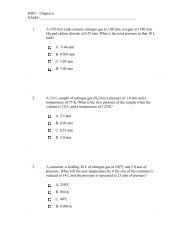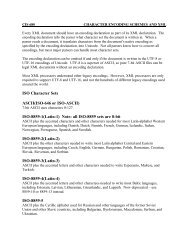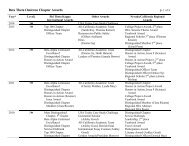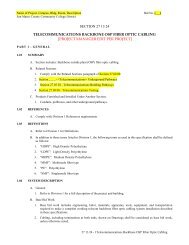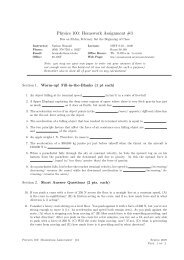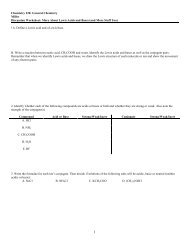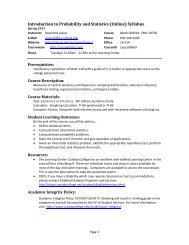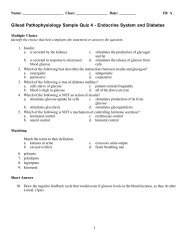Physics 100: Solutions to Homework Assignment #7
Physics 100: Solutions to Homework Assignment #7
Physics 100: Solutions to Homework Assignment #7
You also want an ePaper? Increase the reach of your titles
YUMPU automatically turns print PDFs into web optimized ePapers that Google loves.
<strong>Physics</strong> <strong>100</strong>: <strong>Solutions</strong> <strong>to</strong> <strong>Homework</strong> <strong>Assignment</strong> <strong>#7</strong><br />
Was Due on Friday, March 23 rd at the Beginning of Class<br />
Section 1.<br />
Warm-up! Fill-in-the-Blanks (1 pt each)<br />
1. For a wave, the maximum displacement on either side of the equilibrium (midpoint) position is known<br />
as the amplitude .<br />
2. The distance between successive crests, troughs, or identical parts of a wave is known as the wavelength<br />
3. For a wave, the number of crests that pass a particular point per unit time is known as the frequency<br />
of the wave. For vibrations, the number of vibrations per unit time is known as the frequency<br />
of vibration.<br />
4. The SI unit of frequency is the Hertz , which equals one vibration(s) per second.<br />
5. The time in which a vibration is completed or the time it takes for one wavelength of a wave <strong>to</strong> pass<br />
a certain point is known as the period of the vibration or wave.<br />
6. The speed with which a wave passes a particular point is determined by multiplying its wavelength<br />
by its frequency .<br />
7. A wave in which the medium vibrates perpendicular <strong>to</strong> the direction of travel is a transverse<br />
wave, while a wave which vibrates parallel <strong>to</strong> the direction of travel is a longitudinal wave.<br />
8. The pattern formed by superposition of different sets of waves that produces reinforcement in some<br />
areas and cancelation in others is known as the interference pattern of the waves.<br />
9. The shift in received frequency due <strong>to</strong> motion of a vibrating source <strong>to</strong>ward or away from a receiver is<br />
known as the Doppler Effect .<br />
10. The V-shaped disturbance created by an object moving across a liquid surface at a speed greater than<br />
the wave speed is known as the bow wave . This is similar <strong>to</strong> the cone-shaped<br />
disturbance created by an object moving at supersonic speed through a fluid, which is known as the<br />
shock wave .<br />
Section 2.<br />
Short Answer Questions (2 pts. each)<br />
11. What kind of motion should you impart <strong>to</strong> a stretched coiled spring (or Slinky 4 ) <strong>to</strong> make (A) a<br />
transverse wave and (B) a longitudinal wave?<br />
Answer: (A) You would move the slinky up and down, <strong>to</strong> establish transverse waves as shown in in<br />
the Figure 1, <strong>to</strong>p.<br />
(B) You would move the slinky in and out, compressing and decompressing it, <strong>to</strong> set up longitudinal<br />
waves as shown in the Figure 1, bot<strong>to</strong>m.<br />
4 For info about Slinky’s, visit Wikipedia: http://en.wikipedia.org/wiki/Slinky<br />
<strong>Physics</strong> <strong>100</strong><br />
<strong>Homework</strong> <strong>Assignment</strong><br />
<strong>#7</strong> SOLUTIONS<br />
Spring 2007<br />
Page 1 of 4
v<br />
v<br />
Figure 1: The moving the end of a stretched slinky up and down<br />
makes a transverse wave (TOP). Moving the slinky in and out (compressing/decompressing<br />
it) leads <strong>to</strong> longitudinal waves (BOTTOM). See<br />
Problem 11.<br />
12. You hear an airplane flying overhead and you look up in<strong>to</strong> the sky <strong>to</strong> see it. You eyes see the plane<br />
as being in front of where your ears think the plane is. Does this mean that the airplane is traveling<br />
faster than the speed of sound? Explain for full credit (i.e. just a ‘yes’ or ‘no’ answer will not earn any<br />
points).<br />
Answer: No, it doesn’t mean that the plane is flying faster than the speed of sound– it just means<br />
that the speed of sound is much slower than the speed of light.<br />
When you hear a plane, you are hearing the sound it emitted many seconds ago, because it takes<br />
many seconds for the sound <strong>to</strong> reach your ears (about 5 seconds per mile of distance between you<br />
and the plane). So your ears tell you that the plane is where it was many seconds ago.<br />
Light, however, travels so quickly that it only takes microseconds 5 for the light <strong>to</strong> leave the plane<br />
and reach your eyes (about 5 microseconds per mile)– so when you see a plan, you’re seeing where<br />
it was microseconds ago. So your eyes tell you where the plane was several microseconds ago.<br />
Since the plane may be traveling at speeds around 250 m/s (well below the speed of sound), that<br />
means that your eyes will see the plane as being kilometers ahead of where your ears think they<br />
are.<br />
13. (A) List one example of a longitudinal wave and (B) two examples of a transverse wave.<br />
Answer: (A) Answers include: Sound waves, earthquake P-waves, compressional waves in springs<br />
(like the slinky in Problem 11).<br />
(B) Answers include: Waves in strings (like guitars), light waves, earthquake S-waves. Even<br />
though they’re a mix of both longitudinal and transverse waves, I’ll accept water waves, <strong>to</strong>o.<br />
14. A grandfather pendulum clock keeps perfect time. Then it is taken <strong>to</strong> the moon <strong>to</strong> keep astronauts on<br />
time. On the moon, will it also run with perfect time? Will it run slow? fast?<br />
Answer: The grandfather clock will run slow. Gravity is what keeps the pendulum swinging. If<br />
gravity is weaker, the force that accelerates the pendulum is weaker, meaning that the pendulum<br />
doesn’t travel as fast back and forth. This mens that the period of oscillation increases, so that<br />
instead of taking one second, the period will be longer.<br />
15. How far, in terms of wavelength, does a wave travel in one period?<br />
Answer: It travels exactly one wavelength, by definition.<br />
16. A baby duckling is floating on a lake, not swimming but enjoying the nice, sunny, and windless day.<br />
Waves from a mo<strong>to</strong>r boat pass under the duckling, and the duckling feels itself bob up and down 4<br />
times in 3 seconds. Being very observant, the duckling notices that the waves are moving exactly twice<br />
5 To remind you, a microsecond is one millionth of a second.<br />
<strong>Physics</strong> <strong>100</strong><br />
<strong>Homework</strong> <strong>Assignment</strong><br />
<strong>#7</strong> SOLUTIONS<br />
Spring 2007<br />
Page 2 of 4
as fast as his mother, whom he knows swims at precisely 0.500 m/s. (A) How many wavelengths passed<br />
under the duckling in those three seconds? (B) How many wave cycles did the duckling experience in<br />
those three seconds? (C) What was the frequency of the water waves? (D) What is the wavelength<br />
of the water waves?<br />
Answer: (A) One cycle up and down corresponds <strong>to</strong> one wavelength passing under the duckie, as we<br />
discussed in class 6 . Therefore, in those three seconds, four wavelengths must have passed under<br />
the duckie.<br />
(B) One cycle corresponds <strong>to</strong> the traversal of one wavelength. Therefore, the duckie experienced<br />
four cycles.<br />
(C) The frequency is defined as the number of cycles per second, or, equivalently, the number of<br />
wavelengths that pass per second. In this case, the duckie felt four cycles in three seconds, so the<br />
frequency is:<br />
f =<br />
4 cycles = 1.33 Hz<br />
3 seconds<br />
(D) The speed of the waves is given <strong>to</strong> us as being v = 2 × 0.5 m/s = 1 m/s. Knowing the speed<br />
and the frequency, we can use the all-important wave equation <strong>to</strong> find the wavelength:<br />
wave speed = wavelength × frequency<br />
v = λ × f<br />
λ = wavelength = v f =<br />
1 m/s<br />
1.33 Hz = 3 4 m<br />
17. (A) For each of the waves shown in Figure 2 below, mark the amplitude and wavelength. (B)<br />
Which of the three waves has the longest wavelength? If all three waves have the same frequency, (C)<br />
which wave is traveling the fastest and which the slowest?<br />
Sine<br />
Wave<br />
Triangle<br />
Wave<br />
Square<br />
Wave<br />
Amplitude<br />
Amplitude<br />
Amplitude<br />
Wavelength<br />
Wavelength<br />
Wavelength<br />
Figure 2: Mark the amplitude and wavelength for the waves in this<br />
figure. See Problem 17.<br />
Answer: (A)They’re shown above. Notice that the waves all have the same amplitude.<br />
(B) The square wave has the longest wavelength.<br />
(C) If they all have the same frequency, the square wave must be traveling the fastest as it has<br />
<strong>to</strong> traverse more distance <strong>to</strong> equal one cycle. The slowest wave must be the sine wave since it<br />
has the shortest wavelength and so has <strong>to</strong> traverse the least distance <strong>to</strong> equal one cycle. This<br />
relationship immediately falls out of the wave equation:<br />
wave speed = wavelentgh × frequency<br />
6 If you have any questions about this, come and see me immediately!<br />
<strong>Physics</strong> <strong>100</strong><br />
<strong>Homework</strong> <strong>Assignment</strong><br />
<strong>#7</strong> SOLUTIONS<br />
Spring 2007<br />
Page 3 of 4
If they all have the same frequency, then their speeds are directionally proportional <strong>to</strong> their<br />
wavelengths.<br />
18. (A) What is the relationship between frequency, wavelength, and wave speed? (Write the equation<br />
down– no fancy answers needed for this part.) (B) If the wavelength of a wave were doubled without<br />
changing its speed, how would its frequency change? (C) If the frequency of a wave were tripped<br />
while the wavelength remained constant, how would its speed change? (D) If the speed of a wave were<br />
quadrupled while its frequency remained constant, how would its wavelength change?<br />
Answer: (A) It’s the wave equation! Memorize this!<br />
wave speed = wavelentgh × frequency<br />
(B) To keep the same while doubling the wavelength requires that the frequency be halved. This<br />
makes sense: the wave travels at the same speed, but has <strong>to</strong> go twice as far <strong>to</strong> go through one<br />
cycle. Therefore the frequency drops by a fac<strong>to</strong>r of two.<br />
(C) If wavelength were kept constant while the frequency were tripped while the speed would<br />
triple. This is the same as saying that <strong>to</strong> increase the number of cycles per second while keeping<br />
the distance of travel per cycle constant, you need <strong>to</strong> increase your speed.<br />
(D) If the speed were quadrupled while keeping the frequency constant, the wavelength would<br />
quadruple. A way <strong>to</strong> think about this is that if you increase the distance per second the wave<br />
travels, while keeping the number of cycles passed through per second constant, then the distance<br />
between cycles has <strong>to</strong> increase.<br />
19. A walnut falls from a tree in<strong>to</strong> a shallow pond. The waves that radiate out from it form circular rings.<br />
(A) What does this tell you about the speed of waves moving in different directions?<br />
Answer: (A) It tells me that the speed of sound in all directions is the same.<br />
20. Bats chirp <strong>to</strong> ‘see’ in the dark: they emit ultrasonic 7 pulses of sound and listen for the echoes <strong>to</strong> tell<br />
them how far away things are 8 . As a bat flies <strong>to</strong>wards a wall, is the frequency of the echoed chirps it<br />
receives higher, lower, or the same as the emitted ones?<br />
Answer: Say that the frequency and wavelength that the bat chirps at some frequency when the bat<br />
and its target are sitting still. In this case, the bat emits some frequency, it bounces off the target<br />
and the bat hears the same frequency of sound.<br />
As the bat flies, the sound that it emits in front of it has its wavelength shortened, as in the most<br />
general case of the Doppler Effect of a moving source. This means that the frequency of the sound<br />
that the bat emits is increased, compared <strong>to</strong> the case when it’s sitting still.<br />
When the chirp hits a stationary wall, it reflects back <strong>to</strong> the bat. Now the bat is flying in<strong>to</strong> this<br />
sound wave (chirp), so it hears it being Doppler shifted up again– as in the case of a moving<br />
detec<strong>to</strong>r. So in the end, the bat hears the sound that it emits being shifted higher in frequency.<br />
21. A train is at rest when it starts blowing its horn. Then it begins <strong>to</strong> move <strong>to</strong>wards you. (A) Does<br />
the frequency of the whistle that you hear increase, decrease, or stay the same? (B) How about the<br />
wavelength reaching your ear? (C) How about the speed of sound in the air between you and the<br />
locomotive?<br />
Answer: (A) The frequency of the sound that you hear increases, in accordance with the Doppler<br />
effect.<br />
(B) The wavelength reaching your ear decreases, as in accordance with the Doppler effect of a<br />
moving source.<br />
(C) The speed of sound is not affected by the movement of the train.<br />
22. What can you say about the speed of a boat that makes a bow wave?<br />
Answer: The boat is moving at least as fast the the speed of the water waves.<br />
7 The frequency of the sound waves is beyond the ability of humans <strong>to</strong> hear it.<br />
8 For more information on animal echolocation, I refer you <strong>to</strong> Wikipedia:<br />
http://en.wikipedia.org/wiki/Animal echolocation .<br />
<strong>Physics</strong> <strong>100</strong><br />
<strong>Homework</strong> <strong>Assignment</strong><br />
<strong>#7</strong> SOLUTIONS<br />
Spring 2007<br />
Page 4 of 4



